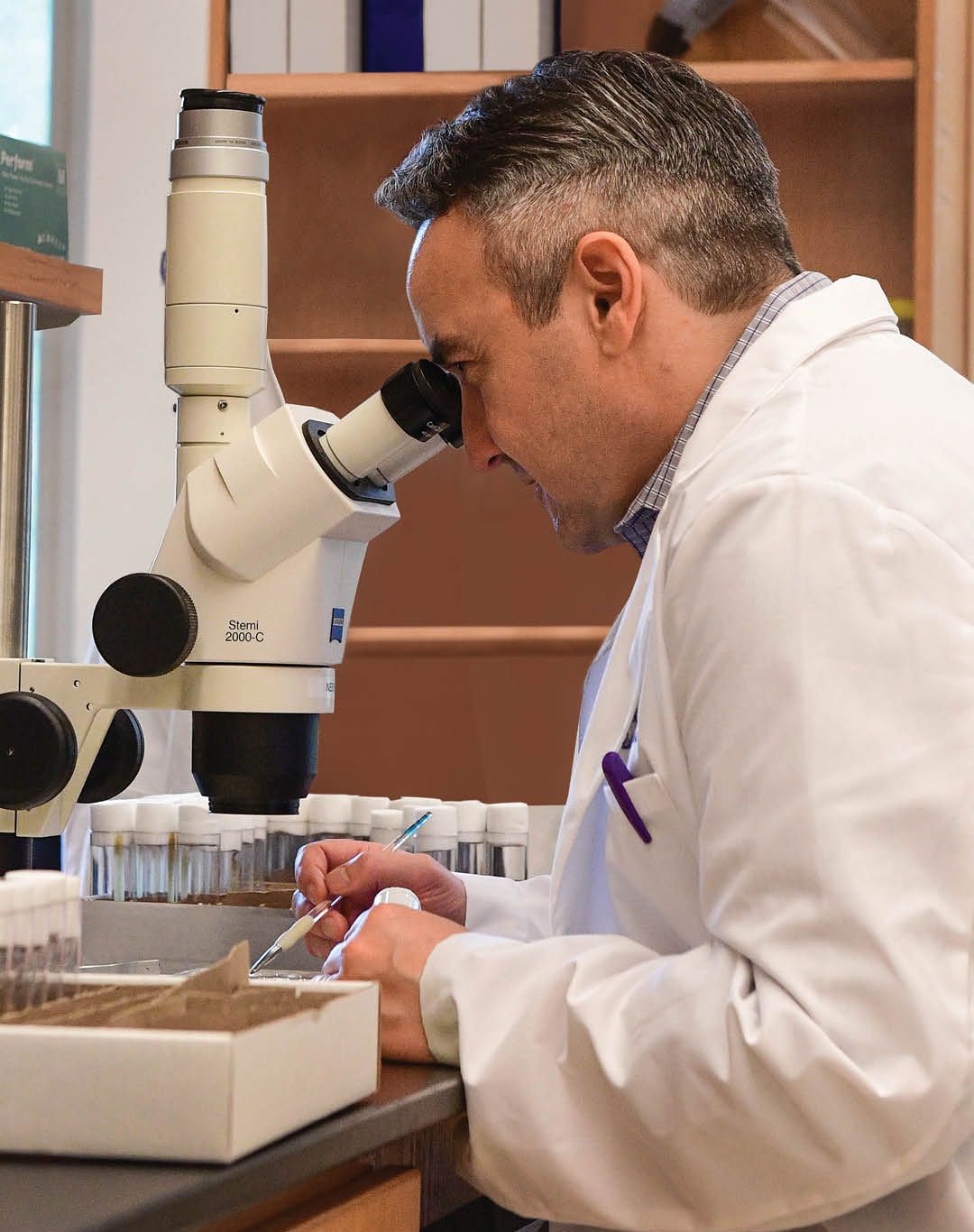THE MIGHTY MICROBIOME
Gut Feeding
Microorganisms that live in and on us are proving important to our health in countless ways

Irene Yang was a health researcher who wanted to know why people smoked. Maya Nadimpalli was a chemist concerned about environmental justice. Jinbing Bai was a nurse researcher in China who witnessed the suffering of children undergoing treatment for cancer. It might be only a coincidence that these different concerns led all three Emory researchers to their present involvement with the human microbiome—or it might also have something to do with the recent enhanced, near-superstar status of the microbiome in human health.

“I knew nothing about the microbiome before I came here,” says Yang, assistant professor in the Nell Hodgson Woodruff School of Nursing. “When I came to Emory and I found out about the microbiome, I realized there was a connection between oral health and the rest of our body.”
That connection by itself is no secret. Researchers have known for decades that the human body harbors literally trillions of one-celled organisms in the intestine, the nose, the mouth, the skin and other body cavities. For the most part, it’s a peaceful coexistence.
Microbiota help us digest food, keep the immune system going, and help synthesize vitamins and amino acids. Occasionally, infectious diseases can disturb that healthy balance. The microbiome’s transition from a supporting role to the limelight began just a few years ago, when powerful new gene–sequencing tools and advances in computing made it possible to track the different makeup of whole colonies of microbes in individuals as well as to determine the exact genome of each microbe species. For the first time, it was possible to catalog the whole spectrum of bacteria living on and inside the body.
“It just kind of blew open the field.”
Researchers at Emory had joined the explosion of research that followed when the NIH created the Human Microbiome Project in 2007. Changes in microbiota could be linked to other changes in the body including antimicrobial resistance, cognitive impairment, bone health, premature births, even psychological stress. In 2018, the Rollins School of Public Health received a $3.5 million grant to study gut microbiome conditions among young children in Ecuador.
That research—which is still in progress—aims to find out whether more diverse gut microbiomes lead to kids with fewer intestinal infections acquired from their environment. Last fall, as part of an outpouring of new research, the NIH’s National Institute of Neurological Disorders and Stroke awarded a $3.9 million grant to the Nell Hodgson Woodruff School of Nursing to study how the oral microbiome contributes to risk of Alzheimer’s disease.
Yang (above, right), principal investigator on that project, says oral bacteria have been found postmortem in the brain, leading to the theory that microorganisms from one part of the body can travel through the blood and cause trouble in other parts.
Another theory, which she’s investigating, is that microorganisms can send chemical mediators that cause reactions in another part of the body including the brain.
“Does a local infection influence neuroinflammation and does that contribute to Alzheimer’s disease risk?” she asks. “That’s the theoretical basis of my current study.”
Yang completed a study showing people with mild cognitive impairment have subtle differences in their oral microbiome, which she thinks is a clue. Her new project will spend three years following people whose family history puts them at high risk for Alzheimer’s, seeking links between cognitive impairment and the makeup of the oral microbiome.
“What we hypothesize,” she says, “is that even if we don’t see big cognitive changes in this population, a certain group of them are going to be moving closer toward Alzheimer’s disease. We’re hoping to see a relationship between the oral microbiome, local inflammation, systemic and neural inflammation, and Alzheimer’s disease risk.”
Current research is broadly divided between two approaches. One looks for correlations to determine whether changes in the body are associated with changes in the makeup of the microbiome, both in the kinds of organisms present and their relative abundance. Other researchers are moving beyond associations to a search for the underlying biochemical processes—the ways the different microscopic bugs impact the body. Not just the correlation, in other words, but the cause.
Endocrinologist Roberto Pacifici studies how the microbiome contributes to bone formation, such as fracture repair. He began his work studying how estrogen prevents osteoporosis and why women tend to get osteoporosis after menopause.
“We discovered many years ago that the immune system was involved in the process.”
He began by searching for a special form of white blood cells activated by estrogen deficiency, which he theorized were in the bone marrow. Then it became clear the cells actually live in the gut. “We decided if they live in the gut and were known to be regulated by the microbiome,” he says, “there must be a connection between the microbiome and postmenopausal bone loss.”
Pacifici and his frequent collaborator, Rheinallt Jones, use a dedicated Emory facility—the Gnotobiotic Animal Core—that houses germ-free mice; lab animals that, as Jones puts it, have never seen a microbe in their lives. “That’s a state that’s never existed in history,” says Jones, director of the facility and associate professor of pediatrics. “You can take germ-free mice and colonize that germ-free mouse with a known microbiome.”
By introducing specific bugs into the gut of a germ-free mouse, researchers can compare the effects of that particular colony to the effects of genetically identical mice from the same litter that have a normal microbiome of 500 to 700 different microbes. This technique allowed them to track the way individual microbes produce specific metabolites, small molecules that emerge when food is converted to energy. One of these, butyrate, sets off a chain of successive molecular processes that ultimately result in more bone formation. Jones and Pacifici call it “the gut-bone axis.”
Jones and his collaborators discovered that multiple types of bacteria produce another metabolite, delta valerobetaine, which blocks the synthesis of carnitine, a substance essential to the body’s energy production. When that happens, by-products wind up stored as fat in the liver. Understanding more about this process might lead to ways to manage the microbiome’s role in obesity.
“We took germ-free mice,” Jones explains. “We either gave them a regular diet, a control diet, or a high-fat diet, a Western-style diet. Some of the mice we gave valerobetaine to. Germ-free mice don’t gain much weight. But when we give them the Western style diet and the valerobetaine, there was dramatic weight gain.”
Jones suspects there’s an evolutionary reason why the gut bacteria have such an important role in fat storage. “Homo sapiens evolved on the plains of Africa, when you only ate perhaps once every three days,” he says. “Storing fat might be a function that you needed to survive. So we’ve evolved this small molecule because of the scarcity of food during most of our evolution.”
Jones (below) and Pacifici expect to discover other microbes producing metabolites with equally powerful effects. Butyrate, says Pacifici, was just “low-hanging fruit.” More immediately, they recognize that some components of the gut-bone axis could be developed into a clinical target for people with bone loss. “Women with osteoporosis tend to have a different microbiome than women without osteoporosis,” Pacifici says. “And there are definitely people that have a microbiome that tends to be more pro-inflammatory who tend to have more bone loss.”
Elsewhere at Emory, new discoveries about the role of the microbiome are sometimes running ahead of the explanations for them. Maya Nadimpalli, assistant professor in the Rollins School of Public Health, found that children who were breastfed had a lower chance of having microbes that were resistant to antibiotics. That’s an especially important finding for kids in developing countries.
“I started thinking about the role of breastfeeding after investigating an outbreak of highly drug-resistant Klebsiella pneumoniae that affected neonatal intensive care units on an island,” she says. “The children died in the most horrific ways you could imagine. I thought, what is a mom supposed to do in that situation?”
Nadimpalli partnered with researchers in Peru to monitor breast feedings in children up to 16 months while examining their fecal samples for microbes that were resistant to major antibiotics. While exclusive breastfeeding had no effect for the first six months, every additional three days of breastfeeding after that was associated with a 6 percent lower risk of children harboring E. coli resistant to key antibiotics.
“When we talk about antibiotic resistance in low- and middle-income countries, we’re often thinking about big-picture infrastructure projects,” she adds. “We need to improve sanitation, we need to improve water, we need to improve hospital infection control. Big ticket items. So then I started thinking, could promoting breastfeeding be a way to help protect kids from drug-resistant bacteria in their environment?”
It’s important to focus on breastfeeding, Nadimpallli says, because baby formula manufacturers are increasingly marketing to low- and middle-income countries. “You have aggressive marketing of formula in settings where people don’t have access to clean water, where antibiotic resistance is already rising,” she says. “To understand whether breastfeeding could be protective, it’s important to have that research done.”
Jinbing Bai learned about the microbiome as a nurse researcher in cancer care. “A lot of times for children, their pain response or cognition has not been fully developed yet,” says Bai, assistant professor in the Nell Hodgson Woodruff School of Nursing. “Take a needle-related procedure. You can see how stressful and painful that is for kids. Children are always struggling, crying. That’s a very normal reaction. It’s important to study this population.”
Previous research and his own experience had shown Bai how children receiving chemotherapy for cancer frequently suffered not only pain but also fatigue, anxiety and depression. Perhaps these forms of stress had a link to the microbiome.
Seeking answers, he collected and analyzed gut microbiome samples and their metabolites from teenage patients at Children’s Healthcare of Atlanta, then compared their microbiota to those of healthy children.
The cancer patients not only reported more psychological stress, particularly fatigue and cognitive dysfunction, but also had lower levels of gut microbes and more metabolites. This led him to suspect that the gut microbiome—and the metabolites produced—influence stress levels.
Bai thinks the gut-brain axis actually works both ways. “It’s a bidirectional communication network,” he says. “A lot of times when the patient’s starting chemo treatment, that’s going to bother the bugs. And the bugs are going to change their brain. But the other thing is that, if you have more brain-related stress, that can be communicated back to the gut as well.” EHD
Written by Tony Van Witsen, illustrations by Ken Orvidas, design Peta Westmaas







Gut Health
Most experts agree that healthy microbiota are diverse, with lots of different species. This keeps pathogenic species such as C. difficile, the microbe that causes diarrhea and colitis, from dominating. There’s less agreement on exactly which species are the best and in what proportions, or how this might differ among individuals or age groups.
So what can you do to have healthy microbiota?

|
Avoid antibiotics where possible. They may be effective for specific illnesses but play havoc with your gut bacteria. |
Get a good night’s sleep—at least eight hours. Recent research found an association between less sleep and less microbiome diversity. |
Avoid eating high amounts of red meat, which seems to have a complex relationship with the gut microbiome. |
||||
|
Probiotics (diet supplements containing live microbes) and prebiotics (foods that support microbiome health) are widely considered good for digestion. But be cautious. Commercial probiotics make a wide variety of health claims, but probiotics are considered supplements, not drugs, and are not regulated by the U. S. Food and Drug Administration. “The specific type of probiotic to take for what conditions, we are not there yet,” says Pacifici. “At the end of the day, we have learned from mice that what matters is the absolute number of bacterial cells.” |
Eat less of the wrong kind of food. Cut down on simple sugars that lurk in processed foods like peanut butter, smoothies, even salad dressings. “People seem to do better when they eat natural foods, non-processed foods,” says Jones. “There’s a big difference in microbiome diversity.” Instead, eat more complex sugars from foods such as honey, dark chocolate, coconut, whole grain, apples, berries, bananas, mangoes and sweet potatoes. |
Develop a good oral hygiene regimen. “The biofilm in our mouth is constantly building up, so clear it out daily and get regular cleanings,” says Yang. “If you don’t clear that away, there’s a good chance the ecosystem will get out of balance, and clusters of more pathogenic organisms will collect and build up and contribute to disease.” |
||||
|
Eat lots of fruits and vegetables. Foods that are naturally prebiotic include garlic, onions, leeks, asparagus, Jerusalem artichokes, dandelion greens, bananas, and seaweed. Fruits, green leafy vegetables, beans, and whole grains also contain the prebiotic fibers your gut bugs crave. |
Other prebiotic foods that can benefit the microbiome include kefir, yogurt with live active cultures, tempeh, kombucha tea or anything pickled, such as kimchi, miso, and sauerkraut. |
Manage stress. Studies have shown there’s a link between stress-producing conditions and afflictions that can change the balance of gut species |
||||
|
Breastfeed. Babies who have been breastfed show a more diverse microbiome than babies who have been formula fed. |
Reduce alcohol intake. Studies show alcohol can promote microbiome dysfunction. |
Drink enough water. which can help increase the proportion of good bacteria to bad bacteria. The recommended amount is enough ounces of water to equal half your amount of pounds in body weight (ex., if you are 160 pounds, about 80 ounces of water daily). |
||||





